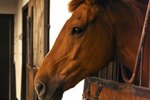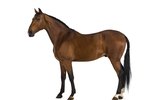
If you're in the market for a sport horse in the English disciplines, consider thoroughbreds and warmbloods. Warmbloods dominate dressage and driving, while thoroughbreds prevail in eventing and foxhunting. In hunter/jumper competition, warmbloods occupy the higher levels, but a thoroughbred revival is under way. Before the large-scale importation of European warmbloods began in the 1970s, thoroughbreds were the breed of choice for most English sports.
Thoroughbreds
In the United States, thoroughbred are bred primarily for racing, not other equine athletic endeavors. That doesn't mean former racehorses can't make the grade in other sports, but it's not the job their breeders intended. Thoroughbreds tend to be more sensitive and more highly strung than warmbloods, whom their detractors term "dumbbloods." Thoroughbreds are often lighter-boned than warmbloods and on average not quite as tall. Thoroughbred breeders don't generally want their horses maturing over 17 hands.
Warmbloods
While the thoroughbred is a specific breed, the term "warmblood" refers to a variety of breeds, many with substantial thoroughbred blood. The simple definition of a warmblood horse is a cross between a hot-blooded breed -- the thoroughbred -- and a cold-blooded breed, such as the draft horse. That's misleading, because European warmblood registries date back generations, if not centuries. Generally, warmbloods are calmer and quieter than thoroughbreds. This makes them more suitable for activities like dressage, which requires intense concentration. Warmbloods tend to be bred for specific disciplines, such as dressage or jumping. Unlike most thoroughbreds, this is their primary, not secondary, sport.
Breeds
Common warmblood breeds include the heavier-boned Hanoverian; the finer-boned and sensitive Trakehener; the Dutch warmblood, a top competitor in many disciplines; the Danish warmblood, well-known in dressage circles; the Selle Francais, a warmblood without a lot of foreign breed influence in its pedigree; the Belgian warmblood, bred with jumping in mind; and the Gelderlander, bred for driving. Other well-known warmblood breeds include the Holsteiner, the Swedish warmblood and the Oldenburg.
Cost
While it will cost you about the same amount of money to feed and care for a thoroughbred as it will a warmblood, the initial purchase price is likely to be far higher for the latter. A top-quality racing or breeding thoroughbred easily runs into six figures, failed racing geldings or mares with mediocre bloodlines are often sold for low prices; otherwise you might be able to adopt one from numerous agencies that focus on second careers for racehorses. When you purchase a well-bred warmblood, you're paying a large amount of money because that horse was bred for the particular sport you pursue.
Brands and Tattoos
Certain warmblood breeds sport a brand denoting their lineage, placed on a specific part of the body. For example, the Trakehener's brand on the right hindquarter is in the shape of a seven-pointed moose antler, according to the Chronicle of the Horse website. The Belgian warmblood's brand, on the left flank, features four horse heads facing different directions. A thoroughbred is not branded, but if it races it is tattooed with a registration number on the upper lip. This tattoo is registered with The Jockey Club, the governing body of thoroughbred racing.
References
Photo Credits
-
Comstock/Comstock/Getty Images
Writer Bio
Jane Meggitt has been a writer for more than 20 years. In addition to reporting for a major newspaper chain, she has been published in "Horse News," "Suburban Classic," "Hoof Beats," "Equine Journal" and other publications. She has a Bachelor of Arts in English from New York University and an Associate of Arts from the American Academy of Dramatics Arts, New York City.



